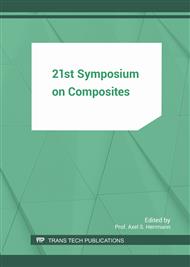p.419
p.427
p.434
p.440
p.447
p.457
p.463
p.473
p.482
Surface Characterization of Carbon Fibers by Atomic Force Microscopy: Roughness Quantification by Power Spectral Density
Abstract:
The topography of a surface consists of structures of different length scales. The surface roughness caused by these structures plays a decisive role in interfacial properties. Atomic Force Microscopy (AFM) can be applied to measure the surface topography with great accuracy and thus facilitates roughness quantification. Here, however, the data reduction poses a challenge. In a conventional approach, surface roughness parameters are evaluated based on averaging height differences, which leads to values dominated by the largest height differences of the surface topography. To quantify contributions of smaller structures to the roughness, a previous study presented a tunable local background correction, which eliminates structures on a larger than selected scale. Therefore, this method only considers surface structures smaller than the chosen scale. A different approach to quantify surface roughness on all length scales covered by AFM measurements uses Fourier transformation of the surface topography to calculate the power spectral density, which describes the amplitudes of different contributing spatial frequencies.In the current study, a new approach based on power spectral density is used to quantify surface roughness parameters as a function of the length scale of contributions to the surface topography. This procedure allows a comprehensive characterization of surface roughness and an intuitive comparison of different surfaces.The usefulness of this method and its compatibility to local background correction is demonstrated by analyzing several commercially available carbon fibers with and without different fiber surface treatments.
Info:
Periodical:
Pages:
447-456
Citation:
Online since:
July 2017
Price:
Сopyright:
© 2017 Trans Tech Publications Ltd. All Rights Reserved
Share:
Citation:


